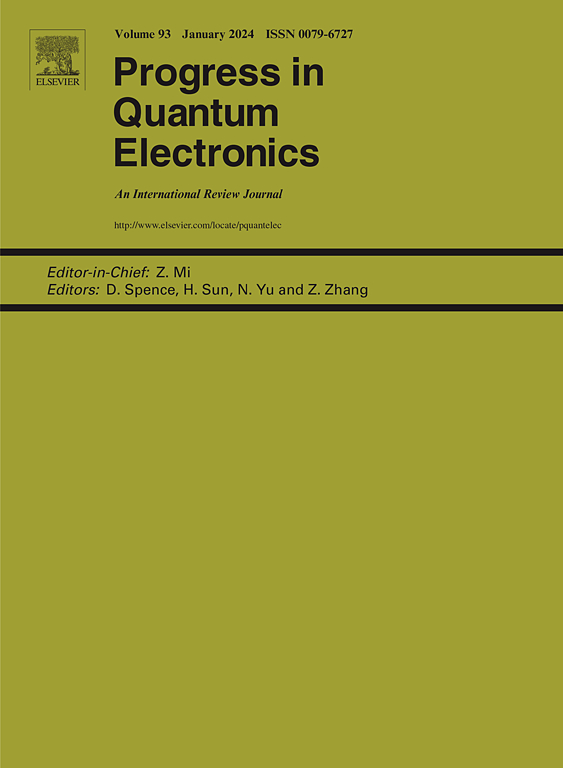高能粒子的量子纳米光子学:x射线和自由电子
IF 12.5
1区 物理与天体物理
Q1 ENGINEERING, ELECTRICAL & ELECTRONIC
引用次数: 0
摘要
在过去的几十年里,精密纳米级和原子级设计的快速发展推动了控制光的产生和传播的革命性进步,从而产生了纳米光子学领域。虽然纳米光子学传统上专注于通过微波操纵电磁波到可见光谱,但最近的发展已将其影响扩展到超短波长范围,包括x射线和自由电子波包。在这篇综述中,我们强调了纳米光子学在这个相对未被探索但技术上具有颠覆性的领域的影响和潜力,展示了纳米尺度和原子尺度的设计如何在与x射线和自由电子相关的量子科学中实现前所未有的技术。我们特别强调了自由电子辐射中由电子-光子纠缠引起的量子现象,包括量子反冲效应,通过自由电子波形增强和控制x射线的产生,以及由自由电子驱动的量子光产生的潜力。材料结构和光的纳米级控制使得在波长尺度上操纵自由电子驱动的x射线和电子波包成为可能,揭示量子特征,并为开发新型、紧凑的光和电子源提供潜在途径。我们还回顾了由准自由电子产生的高谐波产生(HHG),作为极紫外和x射线的来源,包括纳米光学增强和量子光驱动的高谐波产生。然后回顾了x射线波导纳米光子学,包括波导的基本原理,制造,模式结构,以及在相干成像和发射器相互作用中的应用。最后,我们重点介绍了纳米光子学支持的x射线和自由电子的新兴应用,包括量子x射线成像,x射线探测和量子信息技术,其中自由电子被探索为量子探针,信息载体和量子光源。我们的综述强调了x射线和自由电子体制内的独特机会,以及量子纳米光子学通过光子、自由电子和纳米材料之间的定制相互作用来彻底改变这些领域的巨大潜力。本文章由计算机程序翻译,如有差异,请以英文原文为准。
Quantum nanophotonics with energetic particles: X-rays and free electrons
Rapid progress in precision nanoscale and atomic-scale design over the past decades has driven transformative advances in controlling the generation and propagation of light, giving rise to the field of nanophotonics. While nanophotonics has traditionally focused on manipulating electromagnetic waves across the microwave to visible spectrum, recent developments have extended its impact into ultrashort-wavelength regimes, including X-rays and free-electron wavepackets. In this review, we highlight the impact and potential of nanophotonics in this relatively unexplored yet technologically disruptive domain, demonstrating how nanoscale and atomic-scale design enable unprecedented technologies in quantum science related to X-rays and free electrons. We place particular emphasis on quantum phenomena arising from electron–photon entanglement in free-electron radiation, including quantum recoil effects, enhancing and controlling X-ray generation through free-electron waveshaping, and the potential for quantum light generation driven by free electrons. The nanoscale control of material structures and light enables manipulation of free-electron-driven X-rays and electron wavepackets at the wavelength scale, revealing quantum features and offering potential pathways for developing novel, compact light and electron sources. We also review high-harmonic generation (HHG), which arises from quasi-free electrons, as a source of extreme ultraviolet and X-rays, including nano-optics-enhanced and quantum light-driven HHG. The review then explores X-ray waveguide nanophotonics, covering waveguide fundamentals, fabrication, mode structures, and applications in coherent imaging and emitter interactions. Finally, we highlight emerging applications of nanophotonics-enabled X-rays and free electrons, including quantum X-ray imaging, X-ray detection, and quantum information technologies, where free electrons are explored as quantum probes, information carriers, and quantum light sources. Our review underscores the unique opportunities within the X-ray and free-electron regimes and the enormous potential of quantum nanophotonics to revolutionize these fields through tailored interactions between photons, free electrons, and nanomaterials.
求助全文
通过发布文献求助,成功后即可免费获取论文全文。
去求助
来源期刊

Progress in Quantum Electronics
工程技术-工程:电子与电气
CiteScore
18.50
自引率
0.00%
发文量
23
审稿时长
150 days
期刊介绍:
Progress in Quantum Electronics, established in 1969, is an esteemed international review journal dedicated to sharing cutting-edge topics in quantum electronics and its applications. The journal disseminates papers covering theoretical and experimental aspects of contemporary research, including advances in physics, technology, and engineering relevant to quantum electronics. It also encourages interdisciplinary research, welcoming papers that contribute new knowledge in areas such as bio and nano-related work.
 求助内容:
求助内容: 应助结果提醒方式:
应助结果提醒方式:


